Showing all 11 results
-
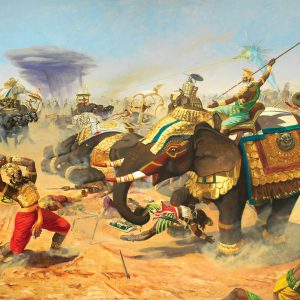
Mahabharata – Bhima and Bhagadatta
£ 145.00 – £ 745.00 BUYBhima is endowed with extraordinary strength and his spectacular feats inspire artistic imagination. He was known for his voracious appetite and in battle he could kill warriors with their elephants only with his mace.
It was possible to trace him on the battlefield simply by following the trail of elephants he had slaughtered. His herculean strength, the fiery character and his total devotion to Lord Krishna and his family led him to perform legendary feats.
The furious and passionate temperament of the great warrior, the bright colours, the red dress, and piercing look of his eyes when fighting – everything speaks about the character of a Kshatriya, always totally committed in defence of society and the moral principles that rule it.
-
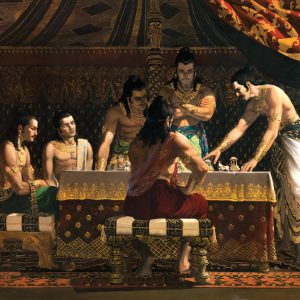
Mahabharata – In the Tent
£ 155.00 – £ 705.00 BUYThe composition and the distribution of the light recall the expressive language of the Italian Baroque period and the atmosphere is inspired by Caravaggio. The dramatic chiaroscuro charges with solemnity the tragic moment that heralds the death of Abhimanyu, the young champion of the Pandava army.
Coloured figurines of soldiers are deployed on the strategic plan, carefully studied by generals. The sharp dark and light enhances the concept that rationality in war has a very relative control over the outcome of the war, other qualities like wrath, courage, strength, resistance and hate contribute strongly to the fulfilment of the destiny. A dramatic sense of the game between karma – destiny – and free will permeate the scene.
-
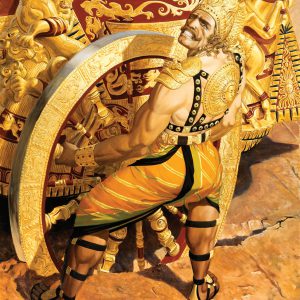
Mahabharata – Karna
£ 155.00 – £ 680.00 BUYKARNA
Karna, the eldest of the Pandava brothers, the first son of Kunti and son of Surya – the sun god, was given up by his mother at birth. Raised by charioteers, tragedy followed him from an early age and his lifelong loyalty to Duryodhana clouded his judgement on many occasions. He was known for his courage, generosity and righteousness.In this artwork Karna, the great hero, is covered with gold. His chariot is stuck to the ground in the midst of the battle due to the terrible course. The tension in the figure, the pride in the eyes, the glitter of the armour, the tragically mired chariot: the plastic use of pictorial matter raises the painting from a mere narrative intent to an intense expressive level.
-
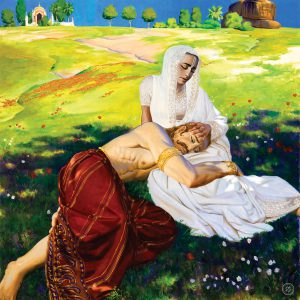
Mahabharata – Karna and Kunti
£ 155.00 – £ 635.00 BUYThis is one of the most moving scenes in the Mahabharata, the moment when Mother Kunti reveals to Karna that he is her first son and therefore the eldest of the Pandava brothers.
Karna is the secret son of Kunti Devi and Surya, the Sun God. On the banks of the Yamuna River, Kunti reveals to Karna the truth about the intimate kinship between them. Their encounter is one of the most poignant moments in the Mahabharata epic, so many sentiments involved in this scene, only piety collecting them all.
-
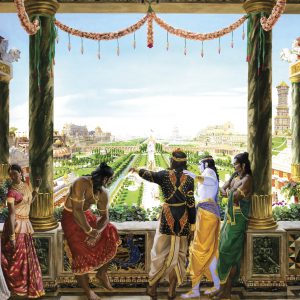
Mahabharata – Krishna in Indraprastha
£ 160.00 – £ 705.00 BUYBefore Indraprastha became the capital of the Pandava’s kingdom, it was the ancient capital of the Kuru clan of which the Pandavas and Kauravas are a part.
At one point in the epic, the Kurus gave the Pandavas a piece of desert land. It had been abandoned for many years and did not look like a place fit to become a capital city. But the Pandavas with the help of Krishna, hard work, determination and skill transformed this wasteland into a beautiful city that would compete with the beauty of Hastinapura, the capital of the empire.
Krishna called upon the heavenly architects Vishvakarma and Mayadhanava, the top designers during that time to transform it into a city fit for the Pandavas. As you can see in the artwork, the architectural accuracy and sophistication made Indraprastha a unique utopia and the perfect example of how cities should be built. Here we can see, in the foreground Maharaj Yudhishthira showing Lord Krishna the great view from the royal palace, as to let us take part in their glance.
-
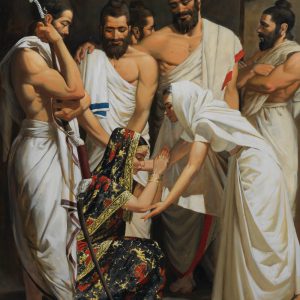
Mahabharata – Kunti and Draupadi
£ 160.00 – £ 795.00 BUYAn intimate simplicity characterises the meeting between Mother Kunti and Draupadi. The painting is devoid of any decorative superfluity. Light is the protagonist of this painting. Taking vantage of the plot in which the Pandavas and their Mother Kunti are in disguise as Brahmanas. They were dressed simply and in white. The white drapery dominates all the lighting, framing the rich black regal sari of Princess Draupadi.
Although Maharaja Draupada’s daughter was elegantly dressed she submits herself to the role of respecting her future mother in law. She was promised to be the wife of the five Pandava brothers, but first she needed to be accepted by their mother!
-
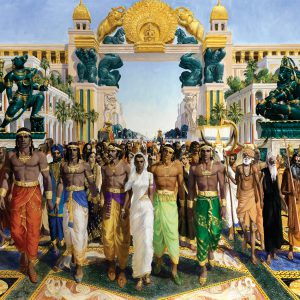
Mahabharata – Pandavas enter Hastinapura
£ 165.00 – £ 660.00 BUYIn this artwork. the Pandava brothers come to Hastinapur after the death of their father, much to the chagrin of Duryodhana. Out of the curiosity and love, all the citizens gather. When the five brothers, enter the city triumphantly with their mother Kunti Devi, accompanied by rishis and great sages.
The composition of this painting shows the frontal view of the crowds that have gathered to greet them and symbolises the entrance of the noble characters into the epic tale, emphasising their presence into the city as well as into the plot of the Mahabharata.
-
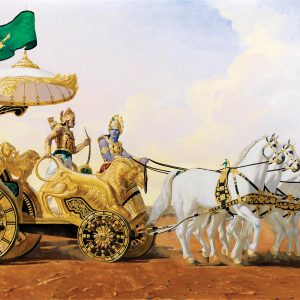
Mahabharata – Parthasarathi
£ 155.00 – £ 755.00 BUYThis is the very heart of Mahabharata, this is the moment that decides how the game will be played. This is the very moment upon which the entire Mahabharata has been written.
The majestic chariot enters the battlefield of Kurukshetra, where the armies are lined up, ready to clash. In these circumstances, Krishna reveals to his friend and devotee Arjuna the secret of Vedic knowledge. The fundamentals of wisdom are conveyed, as he speaks of truth and deception, illusion and reality, virtue, passion and ignorance. The deeper aspects of the psyche, the transcendental nature of the self, the relationship with the Godhead and with other living beings, all come to light very clearly in this dialogue whispered in front of the two armies, and recorded in the Bhagavad Gita (the song of God), one of the primary texts of mankind’s spiritual history.
-
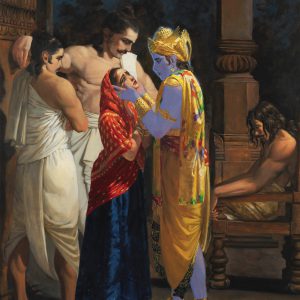
Mahabharata – Save my Honour
£ 160.00 – £ 770.00 BUYOf all the events in the Pandava’s lives, this must be one of the lowest.
Right after having lost the Kingdom and Draupadi’s dignity at the dice contest the Pandavas went into exile in the forest. Krishna saved her honour, by performing a miracle. He provided her unlimited fabric of her sari to prevent her from being disrobed in public.
The nocturnal setting and the light cutting through the darkness, in this moving artwork, contributes to enhance the drama. Krishna consoles Draupadi promising her that everything will be remedied. The desperate face of the woman right in front of the self-effulgent blue God. King Yudhishthira on the right side is the most afflicted, feeling guilty for the big defeat. The painting is in continuity with the “Pandavas were cheated” artwork.
This is the moment when the idea of war mounts seriously although they continued for another 13 year in exile.
-
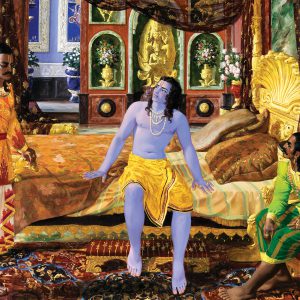
Mahabharata – The Choice
£ 160.00 – £ 790.00 BUYIt is the eve of the great battle of Kurukshetra, when the whole Mahabharata epic is about to be resolved. Sitting on His bed, Krishna announces that He is not going to side with either opponent. He leaves them the choice as to whether to incorporate his powerful personal army into their ranks, or to have Him alone, unarmed and in a secondary role.
Duryodhana, chief of the Kurus, has no hesitation in picking Krishna’s army, where as the Panadavas only desire was to have their dear friend Govinda, Krishna on their side. They are fully convinced that His mere presence on their side will ensure them final victory.
So it is, that Krishna accepts the humble role of driver of Arjuna’s chariot, and thus comes to be known as Parthasarathi.
-
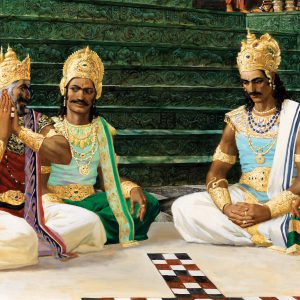
Mahabharata – The Pandavas were cheated
£ 155.00 – £ 770.00 BUYAt the bottom of the steps to the throne, in the middle of the royal room, a tremendous contest happened: it decided the destiny of the Pandava brothers and triggered the tragic event of the Kurukshetra war. The Pandavas are defrauded of royal rights and all belongings by their closest relatives with a rigged game of dice.
Regal dresses hide evil and dishonest personalities. The artist showed mischievous and sinister expressions on the faces of the devious uncle, Shakuni – an expert in the game of dice, and Duryodhana. He wanted to show, expressively, the two very opposing moods of the moment. Arjuna’s resignation, as he knows they are about to lose the contest, and King Yudhishthira’s display of anxiety, for the last throw in the game, where he knows he will lose everything.
